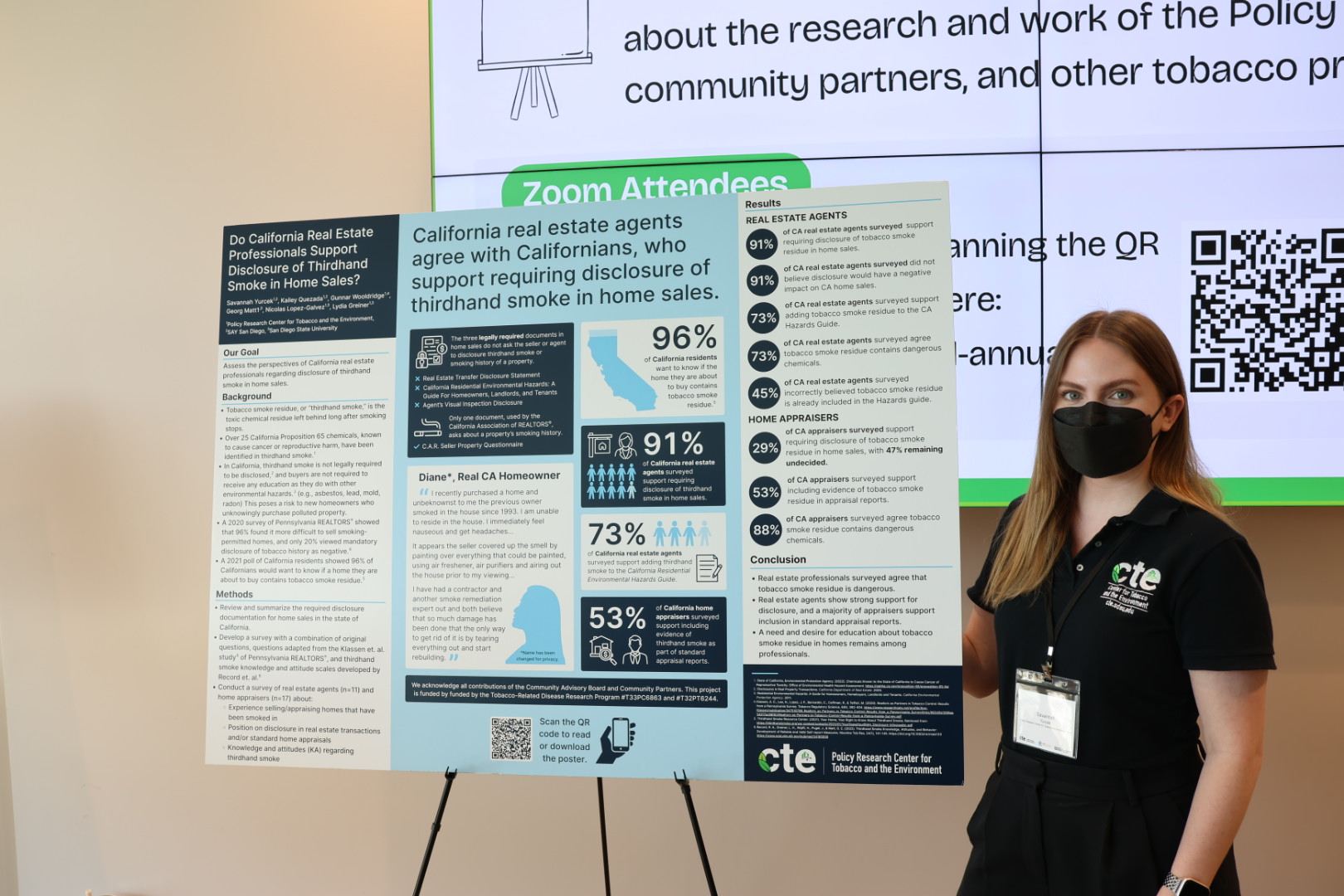Project Updates
Survey Results Show Support for New Disclosure Policies to Protect California Homeowners from Toxic Tobacco Smoke Residue
 California’s required seller disclosure documents fail to protect home buyers from thirdhand smoke. California residents and real estate professionals support seller disclosure of the toxic substance, according to a report by the Policy Research Center for Tobacco and the Environment.
California’s required seller disclosure documents fail to protect home buyers from thirdhand smoke. California residents and real estate professionals support seller disclosure of the toxic substance, according to a report by the Policy Research Center for Tobacco and the Environment.
Click here to read the report today.
Background
Tobacco smoke residue, also known as “thirdhand smoke,” is the toxic chemical residue that is left behind on furniture and in building materials long after smoking occurs. It contains over 25 chemicals listed in California’s Proposition 65, known to cause cancer or reproductive harm. The residue can embed into flooring, walls, and insulation and re-emit into the air for years after smoking has stopped.
It is difficult to remove thirdhand smoke, and in heavily polluted homes, gut renovation may be needed. This pollutant poses serious health and financial risks to new homeowners who may be unaware that smoking occurred in a home until after they have moved in.
Key Findings
Sellers are required to disclose many residential environmental hazards such as lead, radon, asbestos, and mold in home sales in California. After reviewing the disclosure documents legally required as part of California home sales, researchers determined that as of 2025, none of the documents required sellers to disclose whether smoking or vaping occurred on the property or whether thirdhand smoke was present in the home. Only the Seller Property Questionnaire, used by members of the California Association of REALTORS®, asks about the seller’s knowledge of smoking or vaping in their home.
“We were pleased to learn that members of the California Association of REALTORS® are already asking sellers to disclose the tobacco use history of a home, even though this is not required by the California law. Their efforts are commendable.” said Dr. Georg Matt, Director of the Policy Research Center, “But, only about half of California’s real estate agents are members of the Association of REALTORS®. That means only half of real estate agents are asking sellers to disclose tobacco smoke in the homes they are selling, leaving buyers uninformed about this hazard.”
Results from a survey of over 1,800 California residents showed that 96% of Californians want to know if a home they are about to buy is polluted with thirdhand smoke (2021).
Results from recent surveys of real estate professionals suggest that over 90% of California real estate agents support including thirdhand smoke in the legally required seller disclosure statement, and 73% support adding thirdhand smoke to the California Residential Environmental Hazards Guide. Over half of home appraisers surveyed support including evidence of damage from thirdhand smoke as part of the industry standard for home appraisals.
“We’ve known since 2021 that California residents overwhelmingly support disclosure, even people who use tobacco or vape,” noted Dr. Lydia Greiner, Co-Director of the Policy Research Center. “Our new results show that real estate professionals also support disclosure and education of home buyers about pollution from tobacco smoke residue.”
Seller disclosure documents serve the important role of educating home buyers so they can make a more informed decision. Often, seller disclosure documents and real estate agents are the primary sources of environmental hazard information for both buyers and sellers. Requiring disclosure of thirdhand smoke and updating the Hazard Guide to include thirdhand smoke will increase awareness of the hazard and increase transparency in the sale process.
*“Levels of concern” refers to detectable levels of nicotine above background levels expected to be found in a non-smoking environment.
REVIEW OF DISCLOSURE DOCUMENTS
We have completed our review of disclosure documents used during California home sales. Disclosure documents alert buyers to potential defects in the home, including the presence of specific environmental hazards such as lead and formaldehyde. Here is a summary of what we learned!
Environmental hazards are addressed by two documents that are required by California law.
- The California Real Estate Transfer Disclosure Statement (TDS) — The Disclosure Statement is filled out by the seller and informs buyers of any defects in the property, including residential environmental hazards such as asbestos, carbon monoxide, formaldehyde, hazardous waste, and lead. It does not include tobacco smoke on the list of environmental hazards.
-
California Residential Environmental Hazards: A Guide for Homeowners, Landlords, and Tenants (2011) — The Guide includes educational information about residential environmental hazards and remediation, including asbestos, carbon monoxide, formaldehyde, hazardous waste, lead, mold, and radon. It does not include information on tobacco smoke as an environmental hazard.
Environmental hazards are addressed by one other document that is not required by California law.
- The C.A.R. Seller Property Questionnaire (SPQ) — The Questionnaire is filled out by the seller and informs buyers of defects and characteristics of the property.
Summary: A review of documents reveals that (1) disclosure of the history of tobacco use in a home is not required by California law, (2) disclosure of tobacco use and vaping in a home is required by the California Association of Realtors, and (3) there are no requirements for education of buyers or sellers about tobacco smoke residue.
SUMMARY OF REAL ESTATE PROFESSIONALS
Between 10/15/2024 and 12/18/2024, real estate agents and home appraisers who work in California were invited to respond to an online survey.
Real estate agents (n=11) surveyed ranged in age from 43-74 and had an average of 17 years of experience in the industry. Just over half (55%) were female.
Home appraisers (n=17) surveyed ranged in age from 32-79 and had an average of 27 years of experience in the industry. Nearly 2/3 (65%) were male.
Data analysis of the survey results is in progress.
Our survey of real estate professionals in California is in progress.
- We ask about:
- Their experience selling or appraising homes that have been smoked in.
- Their opinion on a law or regulation requiring disclosure of thirdhand smoke in home sales.
- Their knowledge and attitudes toward thirdhand smoke.
- Their demographics.
We have begun preliminary analysis of the survey responses.
Thirdhand smoke residue can stay in a home for years and cause physical symptoms to the residents. The residue is almost impossible to fully remove, and many people would not buy a home if they knew the previous owner smoked inside. However, the State of California does not require sellers to disclose the smoking history inside of a home. The Policy Center wants to get California to require disclosing smoking history.
We will conduct three Rapid Response Projects to answer these questions:
1. What are real estate agents’ thoughts on thirdhand smoke disclosure?
We will survey members of the California Association of Realtors and independent real estate agents.
2. How do other stakeholders feel about disclosing thirdhand smoke?
We will survey appraisers, home inspectors, lenders, and remediation contractors.
3. What makes a disclosure policy successful?
We reviewed all required documents used in California real estate transactions or consumer education about environmental hazards as well as any disclosure documents used in other jurisdictions.

Deliverables:
- Infographic presentations of the survey and interview results
- A presentation for trade organizations, such as the California Association of Realtors San Diego Chapter
- Educational material for home sellers/buyers and other stakeholders
- Model language created with the Public Health Law Center for required and voluntary disclosure forms



